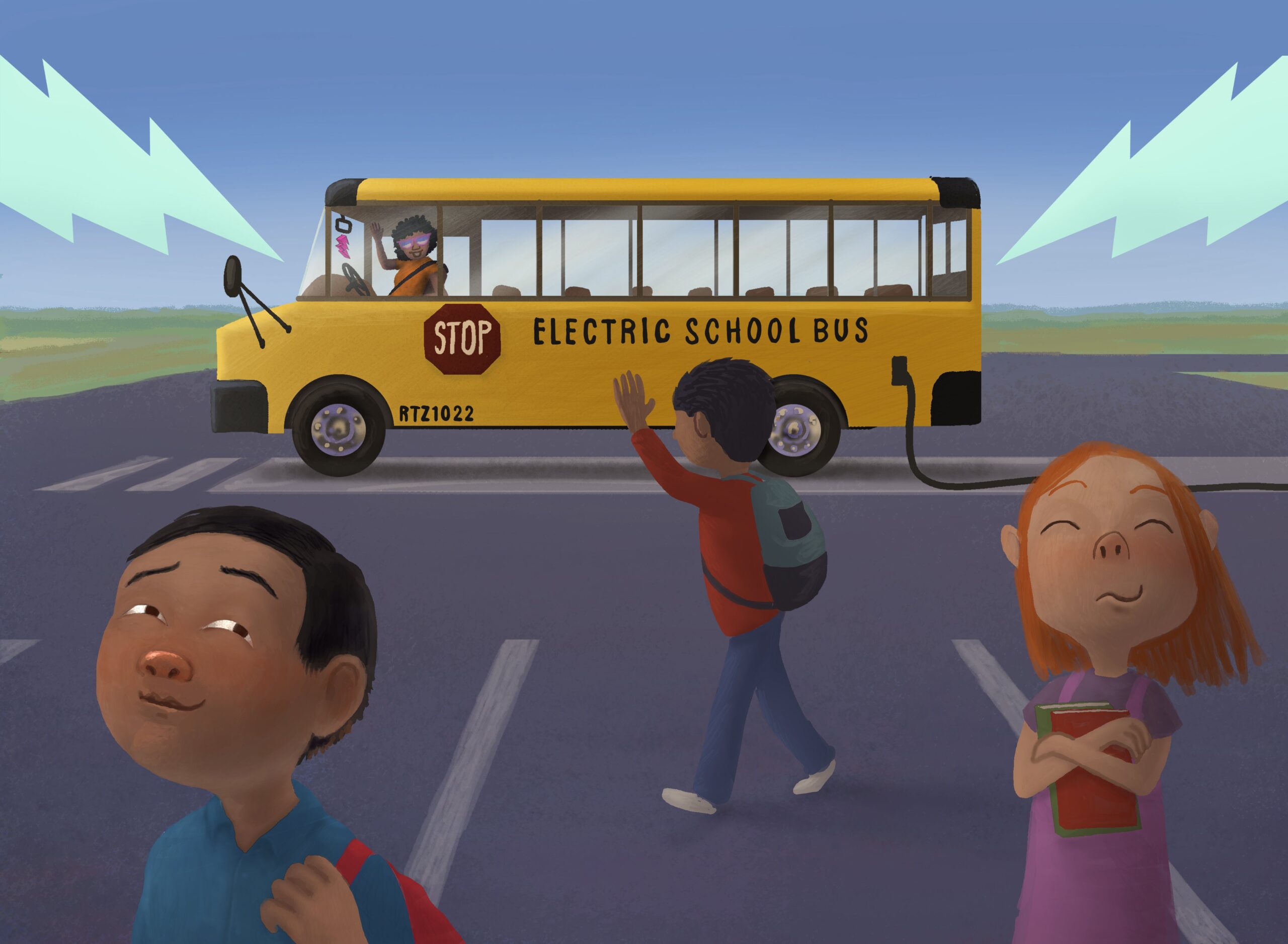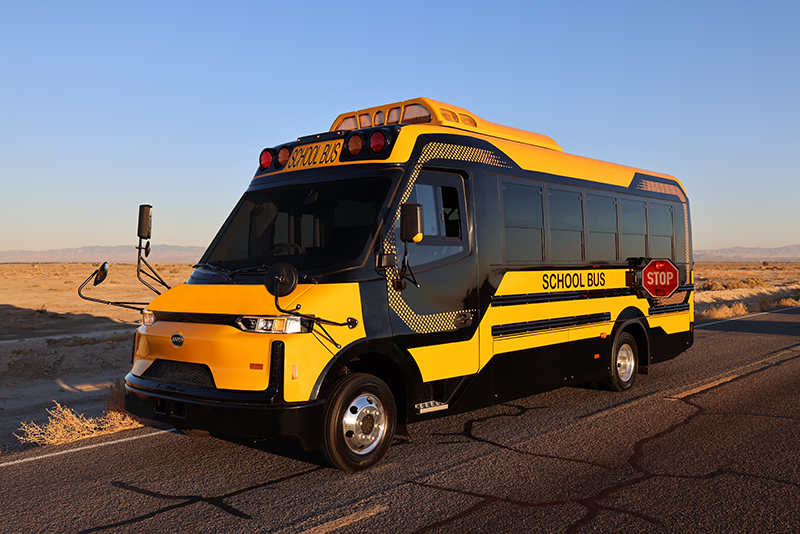The Electric School Bus Is the Climate Hero We Need
The wheels on the bus are powered by clean energy.

This page was published 3 years ago. Find the latest on Earthjustice’s work.
What if schoolkids could ride a magic carpet to school — swift, smooth, silent, with no tailpipe and no exhaust fumes? Alas, magic carpets don’t exist anywhere except in cartoons — but electric school buses do, and they come pretty close. School districts around the U.S. are starting to convert their fleets from dirty diesel buses to pollution-free electric ones, sparking a transformation in how the country’s 25 million schoolkids get to school every day.
The magic electric school bus not only gets kids to school with no exhaust and no pollution, it saves school districts money, creates jobs, protects the climate, and helps communities with a backup energy supply. It truly doesn’t get much better than this.
Federal climate bills passed this year made billions available for electric school buses, putting school districts in a prime position to move ahead on electric school buses. It’s time to hit the accelerator on clean rides for kids.
Electric Buses Save Kids’ Lungs
There are so many reasons to electrify school buses it’s actually difficult to list them all, but let’s start with health. Diesel exhaust produces some of the dirtiest, most toxic pollution in existence that fouls the air in our neighborhoods and directly hurts kids riding in diesel buses.
A 2005 UC Berkeley study looked at pollution from southern California school buses and found that a disturbingly large amount of that pollution gets inside the buses, where the kids riding the bus then breathe it in. The roughly 40 children on a bus inhale as much or more bus-generated pollution than is inhaled by the entire surrounding community.
Children are particularly vulnerable to harm from air pollution. Their lungs aren’t fully developed, and they tend to be outside and active more than adults — meaning they breathe in more of whatever junk is in the air. Research shows that children who grow up in more polluted areas are at greater risk for reduced lung growth, from which they may never recover. The average loss of lung function is about equal to growing up in a home with parents who smoke.
And it goes without saying that combustion engine buses — whether they run on diesel or on fossil gas pump out climate pollution that cooks our planet’s climate. In California, for example, 41% of greenhouse gas emissions come from transportation. This is pollution we can start cutting now.
Not Just Cleaner, But a Better Deal
The magic electric school bus doesn’t just protect kids’ health and our climate. It saves the school district money and helps the local economy. Electric vehicles are cheaper to maintain than internal combustion engines, with far fewer moving parts. And fueling a vehicle on electricity has always been cheaper than gas or diesel fuel: A few years ago, Chicago estimated that each of its electric transit buses saves $25,000 per year in fuel costs. When they’re not carrying kids to and from school or field trips, buses sit idle and can recharge when renewable energy production is high and electricity is cheapest on our grid.
In 2022, the cost of diesel went through the same cost spikes as gasoline, complicating the finances of school districts nationwide. Electric buses eliminate this uncertainty and save serious money. When the Antelope Valley Transit District converted its public transit bus fleet from diesel buses to electric, it quickly tallied well over a million dollars in fuel savings.
The federal government is also making big waves to help school districts electrify their fleets: The EPA recently doubled the first year of funding for the Clean School Bus Program to nearly $1 billion for school districts in all 50 states, all thanks to the Inflation Reduction Act. In total, EPA is making a $5 billion investment over 5 years to replace polluting school buses with clean vehicles.
These clean buses are also good for the local and U.S. economy. Union bus manufacturers like Thomas Built, BYD, and IC Bus (Navistar) are building these buses in facilities where wages, benefits, and worker voices help ensure that electrification creates strong communities and jobs that you can raise a family on. By adopting intentional purchasing practices like the U.S. Employment Plan, school districts across the country have the power to help keep job standards in this industry high so that non-union companies like Blue Bird and Lion Electric are encouraged to make similar commitments to job quality and workforce investment. That’s what’s happened in Southern California, where local unions like the International Brotherhood of Electrical Workers have raised standards to safely and professionally install charging infrastructure for electric school buses.
But wait, there’s more! Electric school buses can store so much energy that they can essentially function as rolling batteries, providing stability and resilience for our energy grid and further helping our transition to clean energy. School districts in 14 states from Florida to Washington are already partnering with local utilities to put electric school buses to use in local energy grids. The Cajon Valley Union School District in San Diego has begun putting its electric school buses in action as a climate-friendly energy resilience tool.

BYD’s “Achiever” electric school bus. This model is made in California by union workers. (Courtesy of BYD)
The Moment to Go Electric Is Now
Back in 2018, New York City started a wave of progress when it committed to operating 100% electric school buses by 2035.
Now electric school buses are replacing dirty diesel buses all over the country, from the Bay Area and Modesto in California to Montgomery County, Maryland and Durango, Colorado. The Los Angeles Unified School District — the second largest in the nation after New York – passed a clean energy resolution in 2019 committing itself to 100% clean transportation by 2040, but is a step or two behind New York in electrifying its bus fleet for the over 42,000 children riding its buses to and from school each day. Angelenos, including the Los Angeles County Electric Truck & Bus Coalition, are encouraging LAUSD to build a fully electric school bus fleet by 2035, which would make it one of the first school districts in the nation to do so.
The technology is here now to replace dirty diesel school buses with something that truly is almost magic — clean, efficient, better for our kids’ health and able to save money for school districts and local communities.
Earthjustice’s Clean Energy Program uses the power of the law and the strength of partnership to accelerate the transition to 100% clean energy.